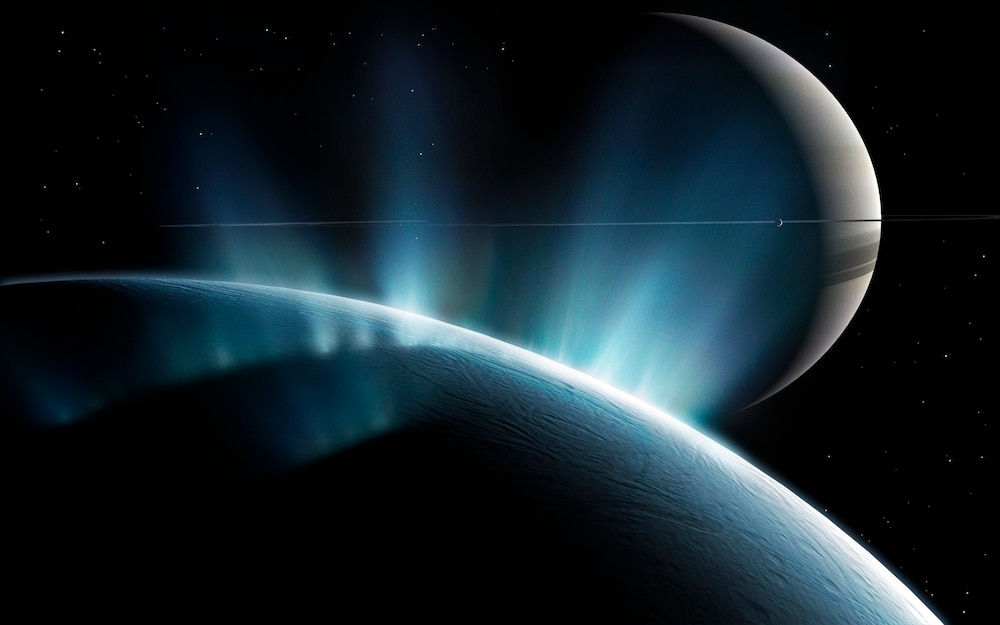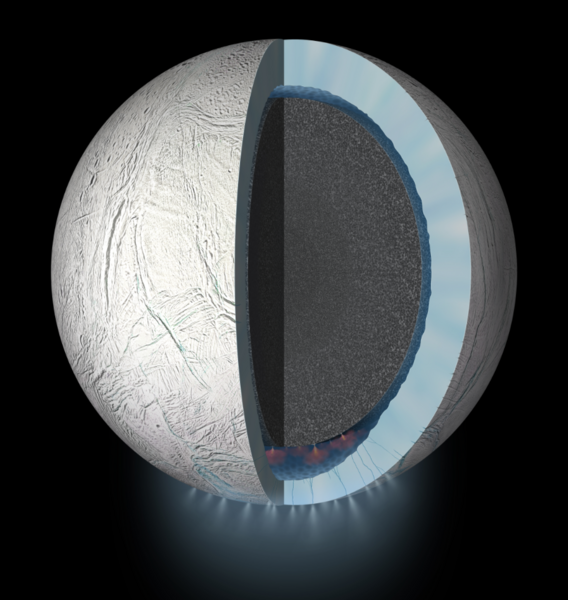Create a free profile to get unlimited access to exclusive videos, sweepstakes, and more!
The Wild Plan to Collect Signs of Alien Life from Saturn’s Moon Enceladus
If it's a success, it will be a smashing success.

Humanity is determined to find life elsewhere in the cosmos, and if we can’t, then we’ll fill it up with life of our own. The 1980 science fiction adventure Saturn 3 (streaming now on Peacock), starring Farrah Fawcett, Kirk Douglas and Harvey Keitel, takes place in a not-so-distant future wherein humanity has spread throughout the solar system.
The story largely follows the tragic events at the titular Saturn 3, an isolated experimental research station on Saturn’s third moon, Tethys. It’s a tiny moon compared to our own, little more than 1,000 kilometers across at its widest point, and its surface is dominated by a massive impact crater on one side. Consequently, Tethys looks like a massive roving eye staring out into space. The next moon in, which we might call Saturn 2, is known as Enceladus, and it’s one of the most interesting places in the solar system.
Capturing Signs of Alien Life from Saturn’s Moon Enceladus
Enceladus is considerably smaller than Tethys, only 498 kilometers (309 miles) across, but astronomers believe it is chock full of surprises. Enceladus is home to a global ocean hidden beneath a layer of solid surface ice. Because of the intense gravitational and tidal forces at work in the Saturn system, the icy moon regularly blasts pressurized jets of water out into space.
RELATED: JWST Reveals 6,000-Mile Water Plume Blasting from Enceladus
Those water ice crystals feed Saturn’s ring system and they could be hiding evidence of aquatic alien life. The ice plumes were first confirmed by NASA’s Cassini spacecraft during the height of its mission. Cassini detected water jets exiting Enceladus at roughly 1,300 kilometers (800 miles) per hour. That’s fast enough that any attempt to grab hold of some crystals would be difficult at best, and that’s without considering the speed of Cassini itself, which is on the order of 70,000 miles per hour with respect to Saturn.
Since their discovery, it has been suggested that we fly a spacecraft through the water plumes for the express purpose of studying the crystals for signs of life, and even returning some of them back to Earth. Any organic material inside the crystals would have to survive a high speed collision with the collection device in the vacuum of space, and no one really knew if that was possible. So, scientists from the University of California San Diego set out to replicate the conditions of capture and confirm whether organics could survive impact with a passing spaceship. The results were published in the Proceedings of the National Academy of Sciences (PNAS).
RELATED: Saturn's Moon Enceladus Has All the Ingredients for Life
Back in 2012, researchers built a device called an aerosol impact spectrometer, designed to study collisions of small particles at high speeds. When they realized they wanted to test impact collisions on ice grains, it was the perfect machine to use. It works by applying a high voltage to an incredibly thin needle and pushing water through it. The voltage forces the water to break up into smaller and smaller droplets. Then those tiny droplets are pushed out of the needle and into a vacuum where they freeze. The frozen grains then smash into a microchannel plate ion detector capable of measuring impact time down to the nanosecond. Lastly, they checked to see if amino acids in the water droplets survived the ordeal.
Experiments showed that amino acids can survive impact speeds up to 15,120 kilometers per hour (9,395 miles per hour). That’s not enough to have survived Cassini slicing through the area at more than four times that speed, but it might be enough for a controlled mission built for that express purpose. It means we don’t necessarily have to carry our alien samples with kid gloves.
Future missions to Enceladus or to other icy ocean worlds, like the Jovian moon Europa, could include collection devices capable of analyzing ice grains on the spot. Or they could scoop up a cosmic snow cone and send it back home for us to enjoy in person.
See Saturn’s moons for yourself in Saturn 3, streaming now on Peacock.




























